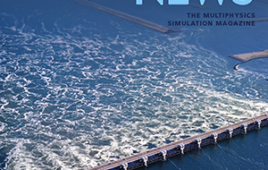One of the remarkable aspects of science is its ability to extend our sense of perception beyond touch and sight, often using the information provided by the “scattering” of waves. A group of researchers from the Department of Civil Engineering, led by Prof Terumi Touhei, at Tokyo University of Science, working on the “inverse scattering” problem has pushed the scope of this. They have developed a method for identifying the location of point-like scatterers based on fluctuations in the physical properties of the surface, namely the Lame? parameters and the mass density. This method has been described in detail in their paper published in International Journal of Solids and Structures. According to Prof Touhei, “This technique of inverse scattering can be used for the imaging of point-like scatterers that are distributed in a complex manner among multiple scattering sources. This could potentially improve the efficiency of tomography for seismic and electromagnetic exploration in geophysics and for nondestructive physical testing of materials.”
Using radiation and scattering patterns is the most popular way of investigating the structural composition of objects. When an incoming wave interacts with the scattering object, it encodes traces of the physical properties of the structure in its outgoing trajectory. By analyzing the radiating wave that scatters off the target, the characteristics of the target object can be studied; this method is referred to as inverse scattering. This scattered, or outgoing, wavefield can be described mathematically by the “Green’s function.” The Green’s function is a tool used to measure the field at one point, which is sourced at a different point. However, since only the near-field observations are available, it is imperative to use them to formulate the far-field operators. The researchers extracted information on the far-field wave properties of the Green’s function by using the so-called “steepest descent path” and “pseudo-projections” methods. Then, the far-field operator was defined based on the near-field observation and the far-field properties of the Green’s function. Given the well-known relationship of sampling methods, the researchers used this far-field operator to obtain the indicator functions that determine the position of the scatterers.
This entire theoretical framework was set up on a grid where each point acted as both source and receiver sensors. By using a predefined object structure as the reference input, the researchers managed to show that the reconstruction using the near-field operator and the indicator functions, based on the calculated far-field operators, matched the input data. The researchers, thus, successfully demonstrated the reconstruction of densely packed point-like scatterers using the sensor grid with a small network. As Prof Touhei states, “The proposed method has the potential to enhance the efficiency of tomography techniques. Thus, it not only bolsters our fundamental understanding of the subject, but also has applications in the imaging of structures that are characterized by a complex distribution of point-like scatterers. These findings are exciting because, in the future, the applicability of this method can also be extended to imaging of the human body.”
The problem of analyzing topology and structural composition arises in many applications wherein one needs to study structures in a given medium. Considering the success of this framework, Prof Touhei states, “The use of sensor grids with a small network can potentially improve the efficiency of imaging techniques for structures where inverse scattering by point-like scatterers with a complex distribution over multiple scattering sources causes a problem. The novel method also keeps a check on the cost of the technique. This puts our research at the frontline of the world in this field.” Backed by numerical computation, this novel approach of pseudo-projections to reconstruct the location of point-like scatterers opens the doors for exploring the deepest crevices of our curiosity.
Filed Under: Product design




